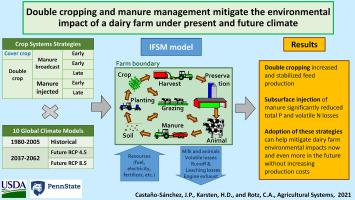Agricultural Systems ( IF 6.1 ) Pub Date : 2021-11-23 , DOI: 10.1016/j.agsy.2021.103326 José P. Castaño-Sánchez 1, 2 , Heather D. Karsten 1 , C. Alan Rotz 2

|
CONTEXT
Strategies are needed to reduce the environmental impacts of dairy farms, and these may become more important as our climate continues to change. Double cropping small grain and corn silages provides a strategy that can benefit dairy farms in the northeastern U.S. as they adapt to a longer growing season. Subsurface application of manure may also reduce nitrogen (N) and phosphorus (P) losses as the region faces warmer temperatures and greater precipitation.
OBJECTIVE
Evaluate whole-farm production, environmental and economic impacts of adopting these strategies on a representative dairy farm in central Pennsylvania under recent historical and projected midcentury climate.
METHODS
Farm management strategies were simulated using the Integrated Farm System Model to determine effects on crop yields, feed production, volatile, leaching and denitrification losses of N, sediment erosion, sediment-bound and soluble losses of P, farm-gate life cycle greenhouse gas emissions, fossil energy use, and production costs.
RESULTS AND CONCLUSIONS
Double cropping increased and stabilized feed production by providing forage from a winter rye crop with less dependency on the summer crops of corn silage and perennial grasses. Summer crops are susceptible to summer droughts, which are expected to increase in this region due to warmer temperatures and increased evapotranspiration. Double cropping was more beneficial in the midcentury climate due to the projected increase in growing season length. Double cropping and subsurface injection of manure reduced total N losses by 12–18% and total P losses by 16–19%. Double cropping using broadcast manure application had a neutral environmental and economic impact on the farm. Adoption of these strategies provided a feasible adaptation and mitigation approach for future climate by reducing projected increases in soluble P runoff and ammonia emission caused by warmer temperatures and greater precipitation while maintaining and potentially reducing total farm production costs.
SIGNIFICANCE
Whole-farm simulation provides a tool for evaluating potential benefits and tradeoffs of novel technologies and strategies as agriculture adapts to changes in climate. Although these results are specific to a dairy farm in central Pennsylvania, they generally apply to dairy farms throughout the Northeast U.S. and climates where similar changes in temperature and precipitation are projected by mid-century. Our analyses suggest that use of a more intensive crop rotation (double cropping winter small grain and corn silage) along with improved manure application technology (subsurface injection) can help mitigate dairy farm environmental impacts now and even more in the future.
中文翻译:

双熟和粪便管理可减轻当前和未来气候下奶牛场对环境的影响
语境
需要制定策略来减少奶牛场对环境的影响,随着我们的气候持续变化,这些策略可能变得更加重要。双季小粒谷物和玉米青贮饲料提供了一种策略,可以使美国东北部的奶牛场适应更长的生长季节,从而使它们受益。由于该地区面临更高的温度和更大的降水,因此在地下施用粪肥还可以减少氮 (N) 和磷 (P) 的损失。
客观的
在最近的历史和预计的世纪中叶气候下,评估在宾夕法尼亚州中部的一个代表性奶牛场采用这些策略对整个农场的生产、环境和经济的影响。
方法
使用综合农场系统模型模拟农场管理策略,以确定对作物产量、饲料生产、挥发物、浸出和反硝化损失、沉积物侵蚀、磷的沉积物结合和可溶损失、农场门生命周期温室气体排放的影响、化石能源使用和生产成本。
结果和结论
双熟通过提供冬季黑麦作物的草料,减少对玉米青贮饲料和多年生禾本科作物的依赖,从而增加并稳定了饲料产量。夏季作物容易受到夏季干旱的影响,由于气温升高和蒸散量增加,预计该地区的夏季干旱会增加。由于预计生长季节长度的增加,双季作物在本世纪中叶的气候中更为有利。双熟和地下注入粪肥使总氮损失减少了 12-18%,总磷损失减少了 16-19%。使用撒播粪肥进行双熟对农场的环境和经济影响是中性的。
意义
随着农业适应气候变化,整个农场模拟为评估新技术和战略的潜在收益和权衡提供了一种工具。尽管这些结果特定于宾夕法尼亚州中部的奶牛场,但它们通常适用于整个美国东北部的奶牛场以及预计到本世纪中叶温度和降水量将发生类似变化的气候。我们的分析表明,使用更密集的轮作(冬季双季小粒谷物和玉米青贮饲料)以及改进的粪肥施用技术(地下注入)可以帮助减轻现在乃至未来奶牛场对环境的影响。











































 京公网安备 11010802027423号
京公网安备 11010802027423号